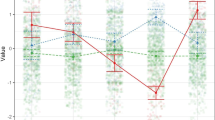Abstract
One of the most comprehensive measures of mindfulness is the Five Facet Mindfulness Questionnaire (FFMQ) with five factors—Observing, Describing, Acting with awareness, Non-judging, and Non-reactivity. Hierarchical confirmatory factor analyses, however, have suggested that only four of the FFMQ factors (i.e. all except Observing) were components of “an overall mindfulness construct”—which is puzzling because Observing represents a core aspect of all definitions of mindfulness. The purpose of the present study was to approach this problem by a person-oriented approach, focusing on patterns on the FFMQ scales, rather than linear associations between them. Data on the FFMQ were collected on 817 individuals. Cluster analysis according to the LICUR procedure was used to group these participants in 13 clusters, according to their profiles of scores on the five FFMQ scales. Of the participants, 325 were categorized as meditators and 317 as non-meditators. To test hypotheses about the relation between Observing and mindfulness (which we assumed should be higher among meditators), the meditators/non-meditators categorization was cross-tabulated with the FFMQ clusters. The results showed that all clusters in which meditators were over-represented had high scores on Observing, and all clusters in which meditators were under-represented had low scores on Observing—which supports the hypothesis that mindfulness is related to high levels of Observing. The relationship between Observing and Non-judging, however, was found to be more complex than expected. The results are discussed in terms of mindfulness seen as a multidimensional skill, which may develop differently in various subgroups of individuals.


Similar content being viewed by others
References
Baer, R. A., Smith, G. T., & Allen, K. B. (2004). Assessment of mindfulness by self-report: The Kentucky Inventory of Mindfulness Skills. Assessment, 11(3), 191–206.
Baer, R. A., Smith, G. T., Hopkins, J., Krietemeyer, J., & Toney, L. (2006). Using self-report assessment methods to explore facets of mindfulness. Assessment, 13(1), 27–45.
Baer, R. A., Smith, G. T., Lykins, E., Button, D., Krietemeyer, J., Sauer, S., et al. (2008). Construct validity of the five facet mindfulness questionnaire in meditating and nonmeditating samples. Assessment, 15(3), 329–342.
Bergman, L. R. (1998). A pattern-oriented approach to studying individual development: Snapshots and processes. In R. B. Cairns, L. R. Bergman, & J. Kagan (Eds.), Methods and models for studying the individual (pp. 82–31). Thousand Oaks.
Bergman, L. R., & El-Khouri, B. M. (1987). EXACON: a fortran 77 program for the exact analysis of single cells in a contingency table. Educational and Psychological Measurement, 47(1), 155–161. doi:10.1177/0013164487471024.
Bergman, L. R. & El-Khouri, B. M. (2002). SLEIPNER. A statistical package for pattern-oriented analyses. Version 2.1. Stockholm: Stockholm University, Department of Psychology. www.psychology.su.se/sleipner.
Bergman, L. R., & Magnusson, D. (1997). A person-oriented approach in research on developmental psychopathology. Development and Psychopathology, 9(2), 291–319. doi:10.1017/S095457949700206X.
Bishop, S. R., Lau, M., Shapiro, S., Carlson, L., Anderson, N. C., Carmody, J., et al. (2004). Mindfulness: a proposed operational definition. Clinical Psychology: Science and Practice, 11(3), 230–241.
Brown, K. W., & Ryan, R. M. (2003). The benefits of being present: mindfulness and its role in psychological well-being. Journal of Personality and Social Psychology, 84(4), 822–848.
Falkenström, F. (2009). Studying mindfulness in experienced meditators: a quasi-experimental approach. Personality and Individual Differences, 48(3), 305–310.
Hansen, E., Lundh, L. G., Homman, A., & Wångby-Lundh, M. (2009). Measuring mindfulness. Pilot studies with the Swedish versions of the Mindful Attention Awareness Scale (MAAS) and the Kentucky Inventory of Mindfulness Skills (KIMS). Cognitive Behaviour Therapy, 38(1), 2–15.
Josefsson, T., & Broberg, A. (2011). Meditators and non-meditators on sustained and executive attentional performance. Mental Health, Religion and Culture, 14(3), 291–309. doi:10.1080/13674670903578621.
Kabat-Zinn, J. (1994). Wherever you go, there you are: mindfulness meditation in everyday life. New York: Hyperion.
Lilja, J. L., Frodi-Lundgren, A., Johansson Hanse, J., Josefsson, T., Lundh, L.-G., Sköld, C., et al. (2011). Five facets of mindfulness questionnaire—reliability and factor structure: a Swedish version. Cognitive Behaviour Therapy, 40(4), 291–303. doi:10.1080/16506073.2011.580367.
Nolen-Hoeksema, S. (2000). The role of rumination in depressive disorders and mixed anxiety/depressive symptoms. Journal of Abnormal Psychology, 109(3), 504–511.
Smalley, S. L., Loo, S. K., Hale, S. H., Shrestha, A., & McGough, J. (2009). Mindfulness and attention deficit hyperactivity disorder. Journal of Clinical Psychology, 65(10), 1087–1098.
Watkins, E., & Teasdale, J. D. (2001). Rumination and overgeneral memory in depression: effects of self-focus and analytic thinking. Journal of Abnormal Psychology, 110(2), 353–357.
Watkins, E., & Teasdale, J. D. (2004). Adaptive and maladaptive self-focus in depression. Journal of Affective Disorders, 82(1), 1–8.
Wishart, D. (1987). CLUSTAN. User manual. Cluster analysis software. Computing Laboratory, University of St. Andrews.
Acknowledgements
We wish to thank Annika Frodi Lundgren and Elizabeth Marcheschi for help with the data collection, and Margit Wångby-Lundh for help with the cluster analysis. This study was partly financed by research grant from the Västra Götalands County Council Research and Development Centre (FoU-centrum i Västra Götaland) and with financial support from Tjörns Health Clinic (Vårdcentralen Tjörn). The authors would like to express their gratitude to the anonymous reviewers for their helpful comments and suggestions on an early version of this article.
Author information
Authors and Affiliations
Corresponding author
Rights and permissions
About this article
Cite this article
Lilja, J.L., Lundh, LG., Josefsson, T. et al. Observing as an Essential Facet of Mindfulness: A Comparison of FFMQ Patterns in Meditating and Non-Meditating Individuals. Mindfulness 4, 203–212 (2013). https://doi.org/10.1007/s12671-012-0111-8
Published:
Issue Date:
DOI: https://doi.org/10.1007/s12671-012-0111-8




